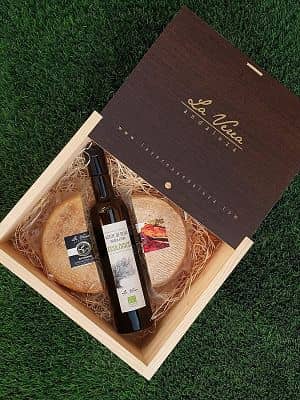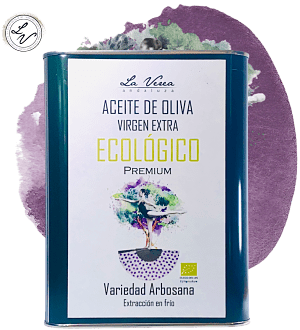This post is also available in:
Español (Spanish)
Deutsch (German)
Frequently Asked Questions Ecological Oil
.
Hemos preparado una serie de Preguntas y Respuestas Frecuentes sobre el Aceite, en general, y el Aceite de Oliva Virgen Extra Ecológico. en particular. Si tienes cualquier duda que no encuentres en esta sección, puedes hacérnosla. Estaremos encantados de resolverla.

Frequently Asked Questions and Answers about Oils
.
Olive oil, let’s get to know each other
.
What is Olive Oil?
It is the result of extracting by grinding the juice of the fruit of the olive tree, the olive. Depending on the quality of the olives harvested, the season and the extraction process, one or another type of oil will be obtained.
What is EVOO?
They stand for Extra Virgin Olive Oil; pure natural olive juice, with no defects in composition, aroma or flavor, and with the best organoleptic properties. The most characteristic and differentiating attributes of a good EVOO are its spiciness and bitterness. All EVOO has a maximum acidity of 0.8%.
Are all Extra Virgin Olive Oils the same?
Within this category there is a somewhat recent “special” category: the AOVEs PREMIUM or early harvest.
These are those harvested when the veraison (ripening) has not started or is very slight in the olive. It depends more on the type of olive than on the date. For example, an arbequina oil will hardly be “early harvest” in November because the olive is already quite ripe while the variety of “arbosana” oil can start its veraison even in January if the weather is good.
It depends more on the type of olive than on the date.
What is Organic Oil?
What differentiates Organic Virgin Olive Oil from other oils is the way in which it is harvested, since for this one all chemicals have been eliminated and only organic fertilizers have been used. This is in accordance with the EU organic agri-food production regulations. La Verea Andaluza has relied on Indlab, an advanced organoleptic, physicochemical, contaminant and residue analysis laboratory recognized by the International Olive Council to certify the purity of the oil. It is free of any unwanted chemicals and in particular glyphosate.
How is it obtained?
Through the process called milling, the Extra Virgin Olive Oil is obtained. This process consists of four parts. First, the olive is crushed to break down the cellular structures that contain the oil inside the fruit. This process is called grinding or milling. Subsequently, the resulting mass must be beaten, so that a homogeneous paste is obtained and the oil droplets unite with each other. This paste is called batido.
Why is this very healthy and delicious oil not marketed in five liters?
We elaborate and pack this organic olive oil always thinking about providing the healthiest and highest quality product possible.
The inertized and steel or glass packaging are expensive processes but they are rewarded by ensuring that all the polyphenols, tocopherols, oleocanthal… in short, everything that makes an organic olive oil as special as this one attractive, remains unaltered until the moment it is opened for at least two years. However, at the very moment the bottle is opened (of this or any other aove), a process of oxidation and degradation of these particles begins, and they gradually disappear.
For our oil to retain its virtues until the last spoonful, it is necessary that the smallest possible amount is in contact with the air, so we sell the oil in small bottles. It is a small price to pay for preserving all its flavor until the last drop.
How many types of olive oil are obtained after the milling and extraction process?
Two types of oils are obtained: 1. Apt directly for human consumption after the extraction process (Virgin Olive Oils): 1.1 The Extra Virgin Olive Oil is the best quality. It has better parameters, both physical-chemical and sensory. To achieve this classification it is essential that a tasting panel assesses it as such. The basic characteristic is that it does not have any olfactory or gustatory defect (smell of humidity, wood flavor, acid flavors…). 1.2 The Virgin Olive Oil, presents lower quality parameters, either physical-chemical or sensory. It is therefore an oil of lower category in relation to the Extra Virgin. Typically, the tasting panel finds some defect, although of a minimal nature. 2. Not suitable for direct human consumption: 2.1 Lampante Olive Oil is that which has notable defects in odor and flavor. There are many factors that can cause this fact: fly-bitten olives, different diseases that can affect it such as fungi, olives damaged during harvesting or transport…. All this will cause the oil to have an acidity (defect) higher than 2%. It is an oil that in order to be used will have to be subjected to thermal and chemical processes to lower these defects caused by fermentation of organic matter. After this process it can be mixed with Olive Oil in a small percentage and, then, it becomes simply Olive Oil. It will have little or no taste or odor, however, it is perfectly edible. 2.2 Olive Oil, as mentioned above, is a blend of Refined Lamp Oil and Virgin Olive Oil. 2.3 Pomace Oil is an oil obtained from the remains of milling. It could be called a by-product and is obtained during the process of milling an overbattering and heating of the mass and subsequent refining in special refineries called orujeras.
Orujo oil is an oil obtained from the remains of the milling process.
What is the best Olive Oil?
The highest quality is the Extra Virgin Olive Oil. Its juice is natural, obtained from healthy and high quality fruits and its maturity is optimal. It presents an extraordinary composition in fatty acids and offers a great variety of sensory nuances. Its use is ideal both raw and in other culinary uses. It is also one of the essential elements of the Mediterranean Diet.
What is the acidity of an oil?
Acidity is a measure of quality. It is measured in oleic acid. It marks the alteration by hydrolysis of the triglycerides of the oil. It serves, together with other parameters, to classify virgin oils into the three categories:
Acidity is a measure of quality.
- Extra
- Virgin.
- Lampant.
.
The degree of acidity is directly related to the freshness of the olives from which the oil is made. The fresher they are, the lower their degree of acidity. The classification of oil types according to their degree of acidity is as follows:
- Extra Virgin Olive Oil: EVOO cannot have an acidity higher than 0.8º. The EVOO of La Verea Andaluza has in this 2020/21 harvest an acidity of 0’1º.
- Virgin Olive Oil: EVOO must have a maximum acidity of 2º or less.
- Virgin Olive Oils above 2º: These are classified as lampante and are not suitable for human consumption.
Extra Virgin Olive Oil, Organoleptic qualities
.
Is EVOO the mildest oil?
Smoothness is a parameter not included in the official EVOO tasting panels and is a subjective sensory perception.
If by mild we mean that it does not sting or bitter, we cannot say that this is positive either, since all the polyphenolic compounds that make Olive Oil healthy contribute a certain degree of stinging and bitterness to it. Most probably the “smoothness” of an oil depends more on the palate of the person who drinks it and his or her comparative experience with other oils he or she has previously tasted.
Is there anything wrong with EVOO that tastes bitter?
The pleasant spicy taste at the end of the throat is a symptom of good quality oil rich in oleocanthal, whose main characteristic is that bitter spiciness.
The sweetness of the oil, which is the main characteristic of this bitter spiciness.
It is usual for an oil to have a clear balance between fruity, spicy and bitter. If it has any accentuated in excess, it is probably not an extra virgin or has a problem.
Is the color of a Virgin Oil important?
The color has absolutely nothing to do with the quality of an oil. Depending on the olive variety or harvesting period, the Extra Virgin Olive Oil can range from green to golden and even almost white. It typically turns a more golden color during aging, however, this is not a general rule either.
.
Extra Virgin Olive Oil and Health
.
Is Olive Oil an anti-inflammatory?
Oleocanthal is a polyphenol, a chemical compound present in Extra Virgin Olive Oil, especially in some varieties, responsible for its slightly spicy flavor. This oleocanthal is found in EVOOs and is similar to oleuropein, which is found in olive leaves and whose molecular structures are similar to ibuprofen and act in a similar way.
Oleocanthal is found in EVOOs and is similar to oleuropein, which is found in olive leaves and whose molecular structures are similar to ibuprofen and act in a similar way.
Does Extra Virgin Olive Oil help prevent skin cancer and other types of cancer?
In 2015 an incredible discovery was made: one of the substances that appears in EVOO, oleocanthal has been found to destroy cancer cells, which has opened enormous avenues of research in the fight against cancer. Perhaps this is another of the secrets of the Mediterranean Diet and its relationship with longevity.
Does olive oil contain vitamins?
Sí, vitamina A, D, K y principalmente E. Tomando cuatro cucharadas diarias de AOVE La Verea Andaluza puedes asegurar tu ración diaria de vitamina E.
Los tocoferoles también ha sido analizados este año por nuestro laboratorio. Puedes consultar todos los análisis y la tabla nutricional en nuestro sitio web.
Olive Oil and Nutrition
.
And for frying?
The main problem when frying food is the generation of the much feared acrylamide in the oil but, curiously, Olive Pomace Olive Oil, having been previously subjected to different thermal and chemical processes, is the most innocuous. It is the best oil for frying, although its flavor will not be as pleasant as virgin or extra virgin olive oil.
How many times can I use it in the fryer?
If you use Olive Oil it will hold a greater number of times than a seed oil, due to its resistance to thermo-oxidation
.
The frying conditions and the food to be fried also affect the number of reuses. For example, if you fry battered or breaded food, it will hold less than if you fry potatoes.
Does olive oil expire?
No, Olive Oil does not expire, it has a best before date but it does not expire. Typically, after two years after milling, not packaging, it will have lost much of its polyphenols (odors and flavors) but it will be totally healthy to consume it. The Extra Virgin Olive Oil is more resistant than the rest to the passage of time as it is the one that has lost the greatest amount of polyphenols, tocopherols, olecocanthal in the milling process and this will help to preserve it with all the organoleptic qualities almost intact for longer than any other. The best way to preserve Olive Oils is to keep them in a cool place, away from heat and light. Therefore, the best packaging for Extra Virgin Olive Oil is the one that protects it from light completely, hermetically sealed and, if possible, packaged in a protected atmosphere.
Do you have any more questions about Organic Oil? We’ll be happy to answer them.
Buy Organic Olive Oil direct from the producer
.

